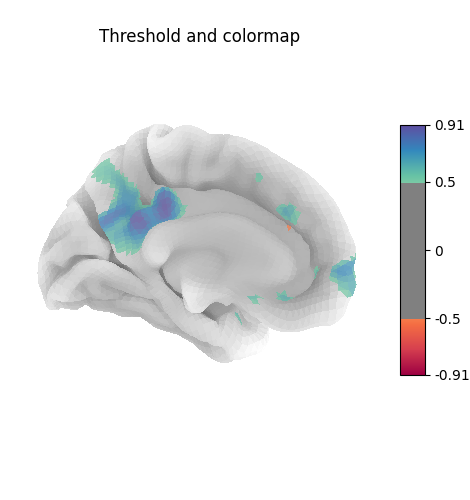Note
Go to the end to download the full example code. or to run this example in your browser via Binder
Seed-based connectivity on the surface¶
Warning
This is an adaption of Seed-based connectivity on the surface to use make it work with the new experimental surface API.
The dataset that is a subset of the enhanced NKI Rockland sample (https://fcon_1000.projects.nitrc.org/indi/enhanced/, Nooner et al.[1] see NKI enhanced surface dataset)
Resting state fMRI scans (TR=645ms) of 102 subjects were preprocessed (https://github.com/fliem/nki_nilearn) and projected onto the Freesurfer fsaverage5 template (Dale et al.[2] and Fischl et al.[3]). For this example we use the time series of a single subject’s left hemisphere.
The Destrieux parcellation (Destrieux et al.[4]) in fsaverage5 space as distributed with Freesurfer is used to select a seed region in the posterior cingulate cortex.
Functional connectivity of the seed region to all other cortical nodes in the same hemisphere is calculated using Pearson product-moment correlation coefficient.
The nilearn.plotting.plot_surf_stat_map function is used
to plot the resulting statistical map on the (inflated) pial surface.
See also for a similar example but using volumetric input data.
See Plotting brain images for more details on plotting tools.
Retrieving the data¶
# NKI resting state data from nilearn
from nilearn.experimental.surface import (
fetch_destrieux,
fetch_nki,
load_fsaverage,
load_fsaverage_data,
)
nki_dataset = fetch_nki(n_subjects=1)
# For this example we will only work on the data
# from the left hemisphere
hemi = "left"
# The nki list contains a SurfaceImage instance
# for the data of each subject along with fsaverage pial meshes.
# Destrieux parcellation for left hemisphere in fsaverage5 space
destrieux_atlas, labels = fetch_destrieux()
parcellation = destrieux_atlas.data.parts[hemi]
# Fsaverage5 surface template
fsaverage_meshes = load_fsaverage()
# The fsaverage meshes contains the FileMesh objects:
print(
"Fsaverage5 pial surface of left hemisphere is: "
f"{fsaverage_meshes['pial'].parts[hemi]}"
)
print(
"Fsaverage5 inflated surface of left hemisphere is: "
f"{fsaverage_meshes['flat'].parts[hemi]}"
)
print(
"Fsaverage5 inflated surface of left hemisphere is: "
f"{fsaverage_meshes['inflated'].parts[hemi]}"
)
# The fsaverage data contains SurfaceImage instances with meshes and data
fsaverage_sulcal = load_fsaverage_data(data_type="sulcal")
print(f"Fsaverage5 sulcal depth map: {fsaverage_sulcal}")
fsaverage_curvature = load_fsaverage_data(data_type="curvature")
print(f"Fsaverage5 sulcal curvature map: {fsaverage_curvature}")
[get_dataset_dir] Dataset found in /home/runner/work/nilearn/nilearn/nilearn_data/nki_enhanced_surface
[get_dataset_dir] Dataset found in /home/runner/work/nilearn/nilearn/nilearn_data/destrieux_surface
Fsaverage5 pial surface of left hemisphere is: <FileMesh with 10242 vertices>
Fsaverage5 inflated surface of left hemisphere is: <FileMesh with 10242 vertices>
Fsaverage5 inflated surface of left hemisphere is: <FileMesh with 10242 vertices>
Fsaverage5 sulcal depth map: <SurfaceImage (20484,)>
Fsaverage5 sulcal curvature map: <SurfaceImage (20484,)>
Extracting the seed time series¶
# Load resting state time series from nilearn
timeseries = nki_dataset[0].data.parts[hemi].T
# Coercing to float is required to avoid errors withj scipy >= 0.14.0
timeseries = timeseries.astype(float)
# Extract seed region via label
pcc_region = "G_cingul-Post-dorsal"
import numpy as np
pcc_labels = np.where(parcellation == labels.index(pcc_region))[0]
# Extract time series from seed region
seed_timeseries = np.mean(timeseries[pcc_labels], axis=0)
Calculating seed-based functional connectivity¶
# Calculate Pearson product-moment correlation coefficient between seed
# time series and timeseries of all cortical nodes of the hemisphere
from scipy import stats
stat_map = np.zeros(timeseries.shape[0])
for i in range(timeseries.shape[0]):
stat_map[i] = stats.pearsonr(seed_timeseries, timeseries[i])[0]
# Re-mask previously masked nodes (medial wall)
stat_map[np.where(np.mean(timeseries, axis=1) == 0)] = 0
/home/runner/work/nilearn/nilearn/examples/08_experimental/plot_surf_stat_map_experimental.py:117: ConstantInputWarning:
An input array is constant; the correlation coefficient is not defined.
Display ROI on surface
# Transform ROI indices in ROI map
pcc_map = np.zeros(parcellation.shape[0], dtype=int)
pcc_map[pcc_labels] = 1
from nilearn.experimental import plotting
from nilearn.plotting import show
plotting.plot_surf_roi(
surf_mesh=nki_dataset[0].mesh,
roi_map=pcc_map,
hemi=hemi,
view="medial",
bg_map=fsaverage_sulcal,
bg_on_data=True,
title="PCC Seed",
)
show()

Using a flat mesh can be useful in order to easily locate the area of interest on the cortex. To make this plot easier to read, we use the mesh curvature as a background map.
bg_map = np.sign(fsaverage_curvature.data.parts[hemi])
# np.sign yields values in [-1, 1]. We rescale the background map
# such that values are in [0.25, 0.75], resulting in a nicer looking plot.
bg_map_rescaled = (bg_map + 1) / 4 + 0.25
plotting.plot_surf_roi(
surf_mesh=fsaverage_meshes["flat"],
roi_map=pcc_map,
hemi=hemi,
view="dorsal",
bg_map=fsaverage_sulcal,
bg_on_data=True,
title="PCC Seed",
)

<Figure size 400x500 with 1 Axes>
Display unthresholded stat map with a slightly dimmed background
plotting.plot_surf_stat_map(
surf_mesh=nki_dataset[0].mesh,
stat_map=stat_map,
hemi=hemi,
view="medial",
colorbar=True,
bg_map=fsaverage_sulcal,
bg_on_data=True,
darkness=0.3,
title="Correlation map",
)
show()

Many different options are available for plotting, for example thresholding, or using custom colormaps
plotting.plot_surf_stat_map(
surf_mesh=nki_dataset[0].mesh,
stat_map=stat_map,
hemi=hemi,
view="medial",
colorbar=True,
bg_map=fsaverage_sulcal,
bg_on_data=True,
cmap="Spectral",
threshold=0.5,
title="Threshold and colormap",
)
show()

Here the surface is plotted in a lateral view without a background map. To capture 3D structure without depth information, the default is to plot a half transparent surface. Note that you can also control the transparency with a background map using the alpha parameter.
plotting.plot_surf_stat_map(
surf_mesh=nki_dataset[0].mesh,
stat_map=stat_map,
hemi=hemi,
view="lateral",
colorbar=True,
cmap="Spectral",
threshold=0.5,
title="Plotting without background",
)
show()

The plots can be saved to file, in which case the display is closed after creating the figure
from pathlib import Path
output_dir = Path.cwd() / "results" / "plot_surf_stat_map"
output_dir.mkdir(exist_ok=True, parents=True)
print(f"Output will be saved to: {output_dir}")
plotting.plot_surf_stat_map(
surf_mesh=fsaverage_meshes["inflated"],
stat_map=stat_map,
hemi=hemi,
bg_map=fsaverage_sulcal,
bg_on_data=True,
threshold=0.5,
colorbar=True,
output_file=output_dir / "plot_surf_stat_map.png",
)
show()
Output will be saved to: /home/runner/work/nilearn/nilearn/examples/08_experimental/results/plot_surf_stat_map
References¶
Total running time of the script: (0 minutes 23.618 seconds)
Estimated memory usage: 935 MB